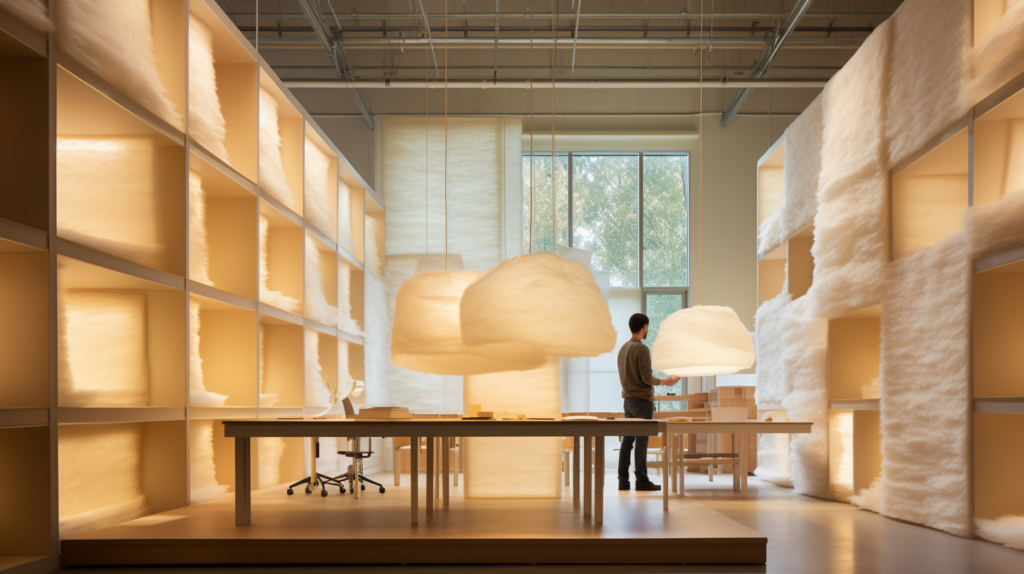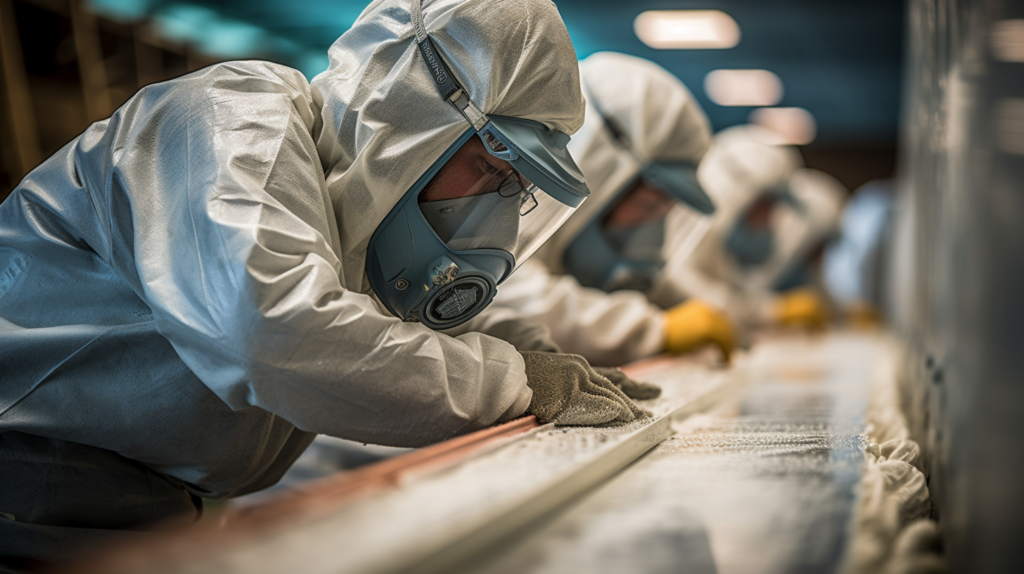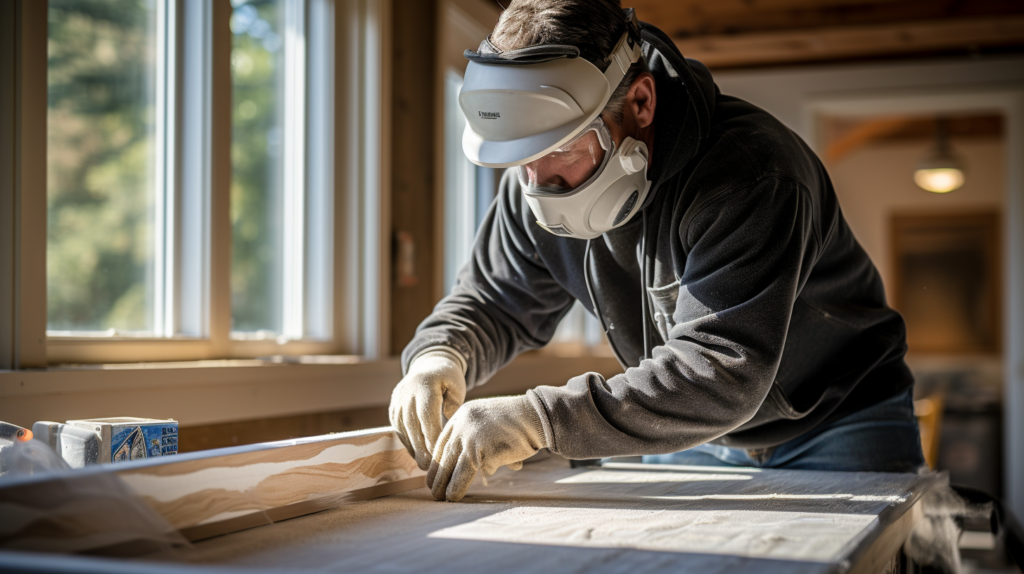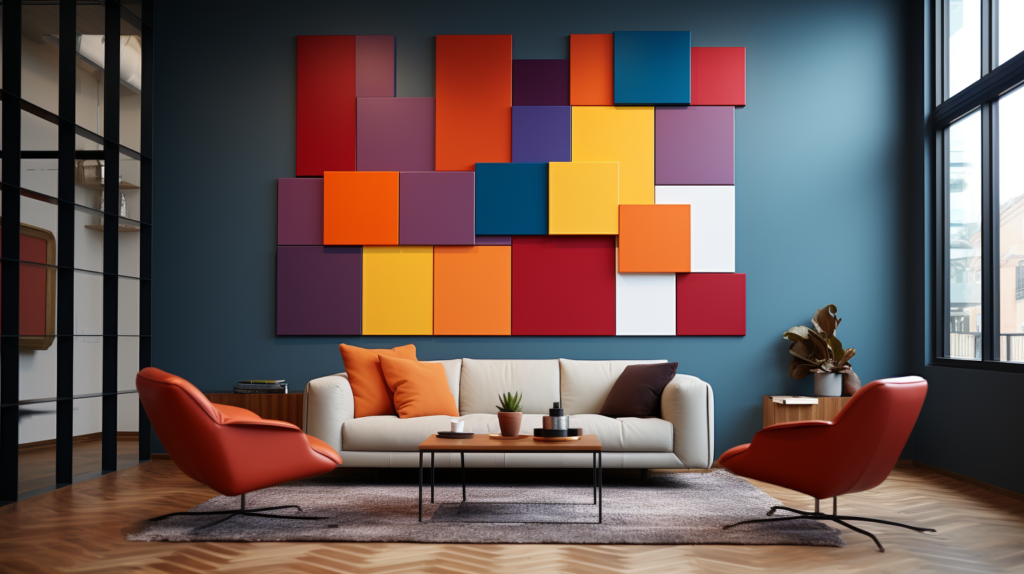You’re finally taking the plunge to create that perfect home theater or perhaps to soundproof your home office.
Acoustic panels are on your shopping list, but a lingering question stops you in your tracks: “Could these panels be dangerous for my health?”
Acoustic panels made of fiberglass have gained a reputation for their excellent sound-absorbing capabilities.
However, they have also sparked debates and concerns about their safety, especially when it comes to long-term exposure.
You’re not alone in wondering whether this popular material is as safe as it is effective.
Ready to demystify the safety concerns around fiberglass acoustic panels?
Let’s dive into the details, and along the way, we’ll introduce you to a safer alternative: polyester acoustic panels.
What Are Fiberglass Acoustic Panels?

Let’s start at the beginning. What exactly are fiberglass acoustic panels? These are panels made from woven fiberglass fibers and are specifically designed to control sound quality.
They are highly effective at absorbing sound waves, which makes them a popular choice for soundproofing rooms or improving the acoustic quality of a space.
They are commonly used in a multitude of settings—from recording studios and home theaters to corporate offices and educational institutions.
Why Choose Fiberglass?

But why fiberglass? The material has been a mainstay in the construction and automotive industries for years.
Its transition into the world of acoustics is, therefore, not entirely surprising.
Its lightweight nature combined with excellent sound-absorbing properties makes it a natural choice for acoustic panels.
However, as with any material, it comes with its own set of pros and cons.
While fiberglass panels are highly effective at what they do, questions about their safety, especially in long-term applications, often arise.
To understand this better, we first need to break down what fiberglass is made of.
What Is Fiberglass Made Of?

When you hear the term “fiberglass,” you might conjure up images of glass shards or think of it as some form of refined glass.
While you’re not entirely off the mark, there’s more to it. Fiberglass is essentially made from fine fibers of glass that are woven into a mat.
These mats are then bonded together with a type of resin, which can vary depending on the intended use of the material. The resulting composite is both strong and lightweight, making it highly versatile.
How Does Fiberglass Absorb Sound?
The sound-absorbing properties of fiberglass primarily come from its porous structure. The woven fibers create a network of tiny air pockets, which trap sound waves, reducing echo and reverberation.
This is why you’ll find fiberglass materials not just in acoustic panels but also as insulation in walls and ceilings. It’s the same principle, applied differently.
However, it’s this very structure—fine, loose fibers—that raises concerns about safety.
These fibers can be irritants, especially when they come into direct contact with the skin or when they are inhaled.
Which naturally leads us to the next question: what safety concerns should you be aware of when dealing with fiberglass?
What Safety Concerns Should You Know About Fiberglass?

Fiberglass is a material that demands respect, especially when it comes to handling it. One of the most immediate concerns is skin irritation.
The glass fibers are fine and can easily penetrate the outer layer of skin, leading to itchiness and discomfort.
While for some, the irritation might be mild and temporary, for others, especially those with sensitive skin, the reaction can be more severe and may require medical attention.
Long-term Health Impacts
Another area of concern is the respiratory system. When fiberglass panels are cut, installed, or even when they deteriorate over time, small fibers can become airborne.
If these fibers are inhaled, they can cause irritation in the lungs, leading to symptoms like coughing, wheezing, and in more severe cases, long-term respiratory issues.
This is a more serious concern for people who handle fiberglass regularly, like workers and DIY enthusiasts, but can also be a potential issue for people who spend time in spaces where the panels are installed.
Can Fiberglass Affect Your Respiratory Health?

When it comes to health, especially long-term health impacts, we all want to be as informed as possible. The issue of whether or not fiberglass can affect respiratory health is a significant one.
For many, especially those with pre-existing health conditions or respiratory issues, this is a topic that can be a deal-breaker when deciding on what type of acoustic panel to use.
The consensus among health experts and studies is nuanced.
While inhaling fiberglass particles is generally not recommended, the likelihood of experiencing severe health issues varies from person to person.
Factors such as the duration of exposure, the concentration of fibers in the air, and individual susceptibility play a role in determining the risk.
Modern Manufacturing Methods Might Mitigate The Risk
That said, modern manufacturing processes have come a long way in mitigating these risks. Many of today’s fiberglass acoustic panels are made with binding agents that help to keep the fibers intact.
These newer panels are less likely to shed fibers into the air, thereby reducing the chances of inhalation.
However, it’s essential to remember that while risks may be low, they are not entirely eliminated.
It’s also worth noting that safety often starts with proper installation.
A correctly installed fiberglass acoustic panel is less likely to shed fibers than one that has been improperly cut or fitted.
Protective measures during installation, including wearing masks and ensuring good ventilation, can further reduce risks.
Therefore, if you’re considering installing fiberglass acoustic panels, it’s crucial to be armed with all the knowledge to do it safely.
Are Fiberglass Acoustic Panels Fire-Resistant?

Another important aspect that often comes under scrutiny is the fire resistance of fiberglass acoustic panels.
When we bring any material into our homes or workplaces, especially in large quantities, it’s natural to wonder about its fire safety.
Nobody wants to install something that could potentially be a fire hazard. So, how do fiberglass acoustic panels measure up in this regard?
Generally, fiberglass is considered to be a fire-resistant material. This means that it won’t easily catch fire and is designed to slow down the spread of flames.
However, it’s crucial to differentiate between being fire “resistant” and fire “proof.”
Fire-resistant means that the material will retard the spread of fire, but it doesn’t mean it’s entirely immune to it.
Look For Class A Fire Rating
When looking to purchase fiberglass acoustic panels, always check for fire safety certifications.
These are usually provided by the manufacturer and indicate that the product meets established fire safety standards.
Most panels that are up to code will have a Class A fire rating, which is the highest standard of fire resistance for building materials.
However, fire resistance is not a permanent attribute. Over time, as panels are exposed to various environmental factors, their fire-resistant qualities can degrade.
This makes regular inspection a necessary part of long-term maintenance. Checking your panels for signs of wear and tear not only ensures their effectiveness but also their safety.
How Can You Safely Install Fiberglass Acoustic Panels?

The topic of installation is where we bring all our knowledge about fiberglass acoustic panels into practical application.
Knowing the potential risks and safety features is one thing; applying them is another. If you’ve decided to go ahead with installing fiberglass acoustic panels, doing it safely should be your utmost priority.
Before you even unbox your panels, make sure you’re equipped with the proper safety gear. A good quality mask is non-negotiable.
This will prevent you from inhaling any loose fibers that might be released during the installation process.
Gloves are equally important, as they’ll protect your skin from direct contact with the fibers, reducing the risk of irritation.
Ventilation is another crucial factor to consider.
Working in a well-ventilated area will ensure that any fibers that do become airborne are quickly dispersed, reducing their concentration in the air and thus the risk of inhalation.
If you’re working in a confined space, consider using mechanical ventilation like exhaust fans to aid in this.
The tools you’ll need for the installation will depend on the type of panels and the surface you’re attaching them to.
However, some general tools that come in handy include a measuring tape for accurate panel placement, a level to ensure your panels are perfectly aligned, and the recommended adhesive or mounting hardware for securing the panels to the wall or ceiling.
The first step in the actual installation process is preparing the area.
This might involve cleaning the walls or ceiling to ensure the adhesive bonds well. Once this is done, you can start measuring and marking the spots for your panels.
It’s advisable to double-check your measurements to avoid any mistakes.
The next step is to apply the adhesive or use the mounting hardware to secure the panels.
Take your time to align them properly; any gaps or overlaps could not only affect performance but also create points where fibers could be released.
Is There Any Alternative To Fiberglass?

If you’ve read through this guide and find yourself concerned about the potential risks associated with fiberglass, you might be wondering if there are any viable alternatives.
The good news is that there are other options available for those seeking to improve the acoustics of a space without using fiberglass.
One such alternative that has been gaining traction is polyester acoustic panels.
Polyester acoustic panels offer many of the sound-absorbing qualities of fiberglass but come with their own set of benefits.
One of the most significant advantages is that they are generally considered to be safer for indoor air quality.
Unlike fiberglass, polyester is a material that does not shed fibers, thereby eliminating the risk of inhalation or skin irritation due to loose fibers.
This makes polyester acoustic panels a particularly good choice for environments where health concerns are paramount, such as schools, healthcare facilities, and homes with children or elderly individuals.
Another benefit of polyester acoustic panels is their versatility and ease of installation. These panels are often lighter than their fiberglass counterparts and can be easier to handle.
They also come in various shapes, sizes, and even colors, providing more options for aesthetic customization.
From a fire safety perspective, high-quality polyester acoustic panels also perform well.
Many are treated to be fire-resistant, offering a level of safety comparable to fiberglass panels.
However, as with any material, it’s crucial to check the fire safety certifications to ensure they meet the necessary standards.
While polyester acoustic panels may not offer the exact same level of sound absorption as fiberglass, they come close.
For many people, the minor trade-off in performance is worth the added safety and ease of use.
Therefore, if you’re looking for an alternative to fiberglass acoustic panels, polyester acoustic panels are a worthy contender.
Conclusion
As we reach the end of this exhaustive guide, you should now be well-equipped with the information you need to make an informed choice about acoustic panels.
From understanding the composition and benefits of fiberglass panels to learning about potential safety risks and precautions, the aim has been to provide a balanced perspective.
We’ve also explored the importance of proper installation and maintenance, emphasizing that even the safest materials can pose risks if mishandled.
And for those still on the fence about fiberglass, we introduced polyester acoustic panels as a compelling alternative, especially when health and ease of installation are significant concerns.
In the end, the choice comes down to your specific needs, the environment where the panels will be installed, and your personal comfort level with the materials.
Whether you opt for fiberglass or polyester, always prioritize quality, adhere to safety guidelines, and don’t hesitate to seek expert advice if you’re unsure.
Remember, the goal is not just to improve the acoustics of your space but to do so in a manner that is both effective and safe.
Thank you for investing the time to educate yourself through this guide, and may your acoustic improvement project be a resounding success!
